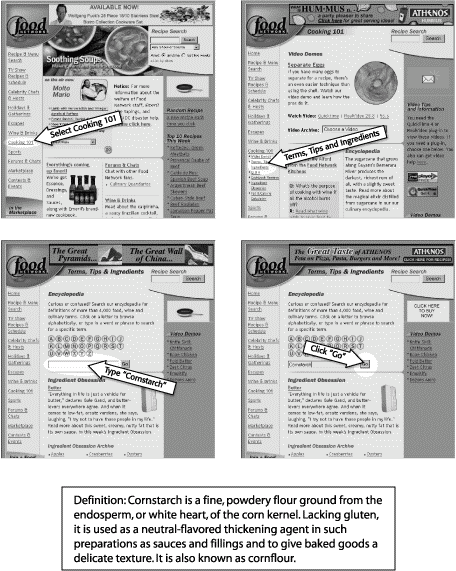WebReference.com - Chapter 4 from Content Management for Dynamic Web Delivery. (3/5)
[previous] [next] |
Content Management for Dynamic Web Delivery
Starting with a personal view of an Information Model
Here is a typical example of how an Information Model might be applied. At home, I have a large collection of cookbooks and cooking magazines, plus lots of recipes cut out of newspapers or sent by friends and relatives. Yet, every time I want to find a particular recipe I remember having used or look for a new recipe for a dish I want to try, I'm stymied by the very books that are such a valuable resource. Where is that recipe? Which book or magazine was it in? Was it last year or ten years ago? Is it in the small green file box or the large cookie tin?

When a sound Information Model is in place, it assists users in finding
the answers to their questions.
The cookbooks I own are organized in various interesting ways. Some are organized by month, based on the original magazine issues. Sunset Magazine, for example, publishes a cookbook annual in which each chapter contains a month's worth of recipes from its magazine. Other cookbooks are organized alphabetically by ingredient or by country of origin. Still other cookbooks are organized by the main ingredient or a part of a complete meal. Several books I own have sections focusing on chicken, pork, beef, or vegetables. They also have sections on soups, desserts, and appetizers. All these different organizations are interesting and effective individually. However, as a complete collection, they fail. They fail because they lack a comprehensive Information Model to support the organization of their content.
How might I improve the organization of the recipes in the cookbooks? First, I would need to understand how I or another amateur cook might search for and use the information. If I'm organizing the content for myself, I might want recipes organized by ingredients, parts of the meal, country of origin, and time to complete. I might also want to organize them by recipes already tried, successful recipes, unsuccessful recipes, new recipes that look interesting but remain untried. All of these categorizes would facilitate searching for just the right recipe for an occasion. In fact, by assigning one or more categories to each recipe, I would be building an Information Model to fit my conceptual view of the cookbook world. If I wanted to include others in my Information Model, I'd need to know something about the categories that would be interesting to them.
The Information Model also assists authors in retrieving information for reuse and revision. It helps us answer questions like
- Where is that explanation of what cornstarch does in a recipe? (See Figure 4-2.)
- Where are the recipes for pasta with asparagus?
- Don't you have an instruction for cutting a chicken into pieces for frying?

Figure 4-2: Just what is cornstarch and what is it doing in my recipe? By
following a link from Cooking 101, the amateur chef locates an explanation in
the Ingredients Encyclopedia on a well-organized Web site. A comprehensive
Information Model underpins the Web site design.
[previous] [next] |
Created: February 6, 2002
Revised: February 6, 2002
URL: https://webreference.com/programming/authoring/languages/html/dynamic/chap4/3.html


 Find a programming school near you
Find a programming school near you